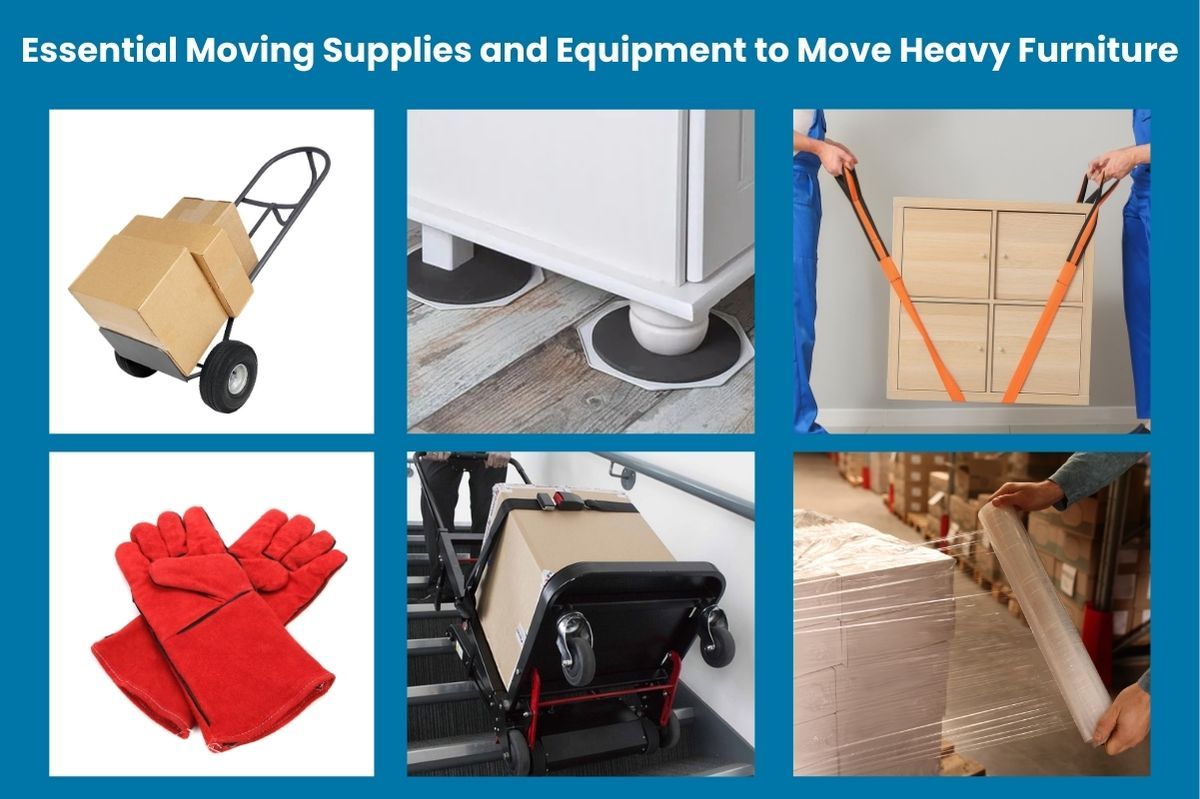Have you ever stood at the bottom of a staircase, a looming furniture piece in tow, wondering just how you'll conquer the task of moving heavy furniture to its new home? Fear not, because with the right strategies and a bit of know-how, even some of the heaviest items can be managed without a pro!
Whether you want to hire one of our expert teams or
move furniture easily
by yourself, we’re here to make sure you survive your next move with your back and your sanity intact. Let's explore 19 easy ways to
move heavy furniture by yourself in
Stewart Moving & Storage's article.
Learn more:
- A Checklist for Virginia Residency Requirements 2025
- Top 10 Safest Cities in Virginia for 2025
- Change of Address Checklist 2025: Who to Inform When You Move to a New Address?
- 16 Military Moving Tips for PCS Moves in 2025 | Army PCS Guide
What is Considered Heavy Furniture?
Furniture is typically considered heavy if it weighs 250 pounds or more. Here are some common items that can be challenging to move by yourself:
- Pianos
- Large Dimension Glass
- Entertainment Centers
- Oversized Dense Furniture made of Oak, Maple or Walnut
- Dressers and Armoires
- Pool Tables
- Exercise Equipment
- Refrigerators and Freezers
- Marble, Granite, or Stone Furniture
- Gun Safe/Safes in General
Read more:

How to Move Heavy Furniture By Yourself: 19 Tips
1. Collect Essential Moving Supplies and Equipment to Move Heavy Furniture
- Moving Dolly: A dolly can help you transport heavy items as it allows you to roll furniture rather than lift it.
- Furniture Sliders: Placing sliders under the legs or corners of heavy pieces can significantly reduce friction, allowing items to slide.
- Lifting Straps: These adjustable straps are designed to assist with heavy furniture lifting and can reduce the strain on your back.
- Heavy-Duty Gloves: Wearing these will protect your hands and improve grip.
- Blankets or Furniture Pads: Using these can prevent scratches, dents, or damage to your furniture, flooring, and walls.
- Stair Roller: Consider using a stair roller, which attaches to heavy items, making it easier to move them down steps securely.
- Ratchet Straps: Use ratchet straps to secure furniture to a dolly or within a moving vehicle to prevent shifting during transit.
- Stretch Wrap: Applying stretch wrap around dressers or cabinets can keep drawers closed and protect the surfaces from scratches or scuffs.
Read more:

2. Plan Your Route and Clear The Landing Area to Move Furniture Easily
When you’re figuring out how to move heavy furniture, don't go into it without a solid plan in place, or you could end up damaging your furniture, your home, or yourself. Map out your exact route and use tape measures to ensure there is enough space. Test out the flooring to make sure it can handle the weight capacity. Clear your landing area completely to give yourself plenty of room.
3. Wear Appropriate Clothing When Moving Large Furniture
Wearing the right clothing is essential for successfully moving heavy furniture. Opt for comfortable, close-fitting clothes that won't get caught on anything. Sturdy shoes with good grip are also important to prevent slips and provide support. Proper attire can significantly reduce the risk of injury. When thinking about how to move heavy furniture, plan your outfit in advance for comfort and stability.
Learn more: How to Move a Grandfather Clock Safely in 10 Simple Steps

4. Clear Out Loose Items From Shelves and Dressers
Before moving shelves and dressers, remove any loose items. This step prevents items from falling and breaking during the move. It also makes the furniture lighter and easier to handle. Organizing and packing these items separately will streamline the moving process.
5. Use Proper Lifting Techniques to Lift Your Heavy Furniture
When moving heavy items, start by standing close to the furniture with your feet shoulder-width apart, giving you a stable base. Keep your back straight, bend at the knees and hips, and lift using the strength of your legs. Never twist your torso while lifting or carrying heavy items, as this can lead to back strain. Instead, pivot with your feet to change direction. Remember to hold the furniture close to your body to increase control and reduce strain on your arms and shoulders. If an item is too heavy, consider hiring professional movers.
Learn more: Moving an Aquarium: How to Pack and Move a Fish Tank
6. Disassemble Your Heavy Furniture When Possible
Taking the time to disassemble heavy furniture can seem like an annoying task, but it's a crucial step in moving furniture easily. Not only does it make the furniture lighter and easier to maneuver through doorways, staircases, and onto the moving truck, but it also helps minimize the risk of damage to other parts of the home. Start by removing any drawers, shelves, or detachable panels. Keep screws, bolts, and other small hardware in labeled bags so that reassembling your items at your new location is a breeze. You can also look back on furniture instructions to make disassembling and reassembling easy.

7. Turn Chairs and Sofas Sideways to Hook Them Around Doorways and Corners
Moving large furniture like chairs and sofas can be challenging, especially when navigating through narrow doorways and tight corners. By turning these items sideways, you can hook them around obstacles more easily, preventing damage and making the process smoother.
Learn more:
7 Essential Cross-Country Moving Tips: Complete Guide
8. Use Furniture Sliders to Move Heavy Furniture or Heavy Objects
After successfully placing furniture sliders under the corners of your heavy item, you’re ready to glide it across the room easily. Slides are effective for moving furniture on carpet, but if you’re dealing with hardwood, laminate, or tile, opt for soft, felt-based sliders to prevent scratches and damage when sliding heavy furniture. Gently push the piece of furniture from the lower section, allowing the sliders to minimize friction and distribute weight evenly. Not only does this method protect your floors, but it also significantly reduces the strain on your body.
9. Considerations When Moving Heavy Objects Upstairs
efore moving heavy items upstairs, always assess the weight and dimensions of the furniture, and the width and shape of the stairwell. Measure doorways, landings, and ceiling heights to avoid getting stuck midway. Always keep the heaviest end of the furniture going up first to reduce the risk of it tipping backward. Communicate clearly with your moving partner, taking slow steps. If the task proves too daunting, don’t hesitate to consult professional movers for heavy furniture.
Learn more:
Tips for Moving Out of State: An Ultimate Checklist
10. Moving Heavy Furniture Downstairs
When going down a flight of stairs, make sure to clear the path of any obstacles to avoid tripping or damaging the furniture. Use moving straps or a furniture dolly to reduce the burden of weight and help maintain a controlled movement. It’s also essential to take slow steps and communicate with your partner. Make sure to place the lighter end facing down the stairs and the heavy portion at the top so it will not slide down quickly, making moving furniture easy and not putting too much strain on one person.

11. Protect Your Furniture and Home with Blankets and Plastic
When moving heavy furniture, use blankets or plastic to safeguard your home's walls, floors, and door frames from scuffs, scratches, or dents. Moving blankets, often made from thick, quilted fabric, provide a barrier against bumps and jolts during transportation, effectively preventing damage to both your furniture and home surfaces. Secure these blankets with high-quality plastic wrap. Not only does the plastic shield your items from moisture and dirt, but it also helps you maintain a grip on slippery surfaces. Don't forget to cover high-traffic areas in your home with non-slip floor protectors to prevent scuffs and allow easier maneuvering of heavy items.
12. Consider Carrying Valuable Items With You
When you're traveling or moving, protecting your most valuable possessions is extremely important. Hand-carrying valuable items means they stay with you at all times, reducing the risk of theft, loss, or damage that can occur with checked luggage or shipped goods. Whether it's expensive jewelry, family heirlooms, or sensitive documents, keeping these items on your person helps you maintain control over their security.
Read more: 10 Packing Tips for a Long-Distance Move from Expert
13. Remove Doors or Door-Stop Molding
Sometimes, the pesky door frame or door edge can be the few inches that hinder your movement of large furniture. Before you begin, measure the width of your furniture and make sure that the door does not limit your movement. If you need to, remove the door from its hinges to get extra space. You can also temporarily remove the door-stop molding so that you don’t catch your furniture on anything as it moves. These precautions will also prevent damage to the door and frame.
14. Use Furniture Carrying Straps or a Dolly
Furniture carrying straps are a great option to help you maneuver heavy items, as the weight is distributed, making less strain on joints and muscles. A dolly can also help you move heavy items with ease, as the wheels take over the pressure caused by pushing the item. Don’t try to move heavy furniture the hard way! Carrying straps and dollies make moving furniture easy.
Read More:
5 Helpful Tips for Moving in the Winter
15. Cut and Fold a Box Spring
Box springs can be very rigid and tight, which makes it almost impossible to move them up tight stairwells or hallways. Thankfully, many box springs are built to fold. In most models, you can slice the center and then fold it in half for your move. After you safely relocate the box spring, reattach and rebuild it with metal brackets or wood screws. Before you cut a box spring, though, make sure that you read your manufacturer's guide so you don’t disrupt any sort of warranty.
16. Make a Mattress Sling for Easy Carrying
Although easier to maneuver than a box spring, a mattress can still be very awkward and heavy to move. Adding a sling is a great option. All you need to do is get a sling rope or strap and then loop it under the mattress and hold onto the two ends of the rope. Each person can then hold the straps securely instead of trying to wrap their hands around the soft mattress.
Read More: How Long Does It Take Movers to Move Cross-Country?
17. Transport Mirrors and Glass with Suction Cup Handles
Moving mirrors and glass can be a stressful process. To reduce that stress and ease your move, purchase suction cup handles from a local hardware store. These can attach to glass items without the risk of damage, but the secure hold is strong. Instead of carrying them just by hand and potentially losing grip, you instead carry them by the sturdy handles. Even with this method, it’s a good safeguard to wrap your mirror or glass with a blanket or bubble wrap to have the most protection possible.
18. Zip Tie Plastic Moving Bins to Prevent Spills
Plastic storage bins are becoming a more popular way to move your items, as they are more secure than cardboard boxes and can be used in your new home! Many of these boxes, though, have unsecured lids. For this type of plastic bins, pick up some heavy-duty zip ties from your local hardware store. Zip-tying the lid before your move will ensure that your items stay safe during the moving process.
Read more:
Getting Organized After Moving
19. When to Consider Hiring Professional Heavy Furniture Movers
Professionals are equipped to handle large, bulky items with care and expertise, ensuring nothing gets damaged—including your back! If you're dealing with particularly heavy pieces, if you have to navigate narrow passageways, if you own valuable or antique furniture that requires special handling, or if you simply lack the necessary equipment and manpower, get some extra help. Professional movers have the training and tools to move heavy furniture efficiently. Hiring professionals is the best way to move furniture easily. Whether you’re looking for help with a local move or need cross-country movers, the experts at Stewart Moving & Storage can help you create a moving plan that meets your needs.
Read more:

These moving packing tips will help you move heavy furniture easily without causing damage to your furniture, your home, or your back! If you decide you need a hand with your long-distance or local move, office moving, or military moving services, contact Stewart Moving & Storage today to receive a custom moving estimate.
> Learn more:



